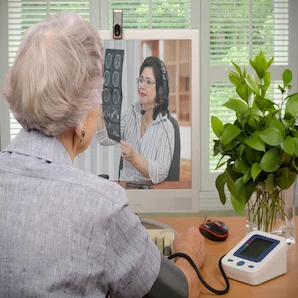Teleradiology and artificial intelligence (AI) can work hand-in-hand and align their respective potential to greatly impact healthcare delivery. The exponential development of high-speed telecommunications networks have opened the way for vast amounts of data to be transferred across the globe instantly. This provided the grounds for the emergence of teleradiology, a tool that allowed radiologists the access and freedom to diversify they way they practice. In a study published in Academic Radiology, the case is made for artificial intelligence being a gamechanger that creates great possibility (and healthcare administrator's dream) of what authors state many have envisioned and described as “an army of fellowship-trained radiologists with IQs of 500 and photographic memories who can work without food or rest.”
You may also like: The AI-powered radiologist
Teleradiology is a tool which allows:
(a) imaging work to be distributed in the manner of cellular osmosis from locations of higher demand and lower supply to the converse, (so that, eg, the radiology group that was required to place a radiologist at a low-volume imaging center could also have the same radiologist report in parallel studies from the busy community hospital emergency room during the periods of his or her downtime).
(b) Work to be transmitted across time zones, allowing the 1-am emergent rule out small bowel ischemia CT angiogram study with its numerous and exacting thin slices and reformats to be interpreted by a radiologist across the globe at 1 pm who had the alertness of mental faculty to be able to detect the diminutive mesenteric artery filling defect, the subtle small bowel wall pneumatosis and/or the infinitesimal loculus of portal venous gas that clinched the diagnosis.
(c) Complex and subspecialised advanced imaging studies to be routed to the appropriate subspecialist.
(d) Access to be provided to remote locations with basic imaging such as digital radiography, where no radiologist was available on site.
In the last ten years or more, teleradiology as a tool has played a key role to address the emerging problem of radiologist shortages. As a direct result of these increasing shortages and the exponential growth of imaging work volume, radiologist burnout has emerged as a serious and detrimental epidemic among healthcare professionals and radiologists especially. Despite the temporising solution provided by the application of teleradiology, the fundamental and overwhelming issue of too many images and not enough radiologists remains. Ultimately the total number of radiologists, however well utilised, is still finite and relatively static or arithmetic in progression, yet the number of images being generated is more along the lines of geometric progression resulting in an overall mismatch, which in turn results in increased rates of radiologist fatigue and error.
Into this scenario has entered a gamechanger in the form of artificial intelligence (AI) which creates the somewhat Dystopian yet highly potent possibility (and healthcare administrator's dream) of what has been envisioned and described as “an army of fellowship-trained radiologists with IQs of 500 and photographic memories who can work without food or rest,” states the report.
AI and teleradiology
There are some striking similarities between teleradiology and artificial intelligence (AI):
- Both have been enabled by the information technology revolution. And in the case of both it is two sequential leaps in technology that have propelled them to radiology's center stage. In the case of teleradiology it was the development of the DICOM standard followed by the rapid advances in telecommunications, while in the case of AI it was initially the development of neural network algorithms followed by the more recent catalyst in the form of the development of Graphic Processing Units that allow for efficient parallel processing of large amounts of data at exceptionally high speed. A related analogy is that both have descended from other progenitor industries, in that the teleradiology industry (or at least the overseas after hours component of it) was to an extent inspired by the software industry developing global data centres to ensure 24 × 7 business continuity. And AI has its technological roots in the gaming industry, which prompted the development of high speed Graphic Processing Unit processors.
- Both are disruptive technologies. In that sense both transform the status quo, give rise to suspicion, essentially related to a lack of understanding, and have the potential to generate fear among those who see them as a threat rather than an ally. In the early days of teleradiology there was a groundswell of fear and loathing of the industry stemming from the concern that some radiologists felt that their job or income was threatened by teleradiology. In point of fact the threat, if there was to be any, was related to the ethics and policies of the individual teleradiology practice or organization rather than teleradiology as a whole, the ethical practice of which has been seen to be of benefit worldwide. A similar perception has been seen in the early days of AI. At the end of the day, therefore, both teleradiology and AI can be viewed either as a threat to be feared or as an opportunity to be embraced. Ultimately it is all in the perception.
- Both help radiologists, when used judiciously and scientifically, in the appropriate use case scenario. As teleradiology clinical paradigms evolved it was seen that it delivered maximum benefit if used in certain specific delivery environments. For example in the emergency department the use of teleradiology could significantly accelerate report delivery while ensuring commensurate levels of compliance in terms of critical value communication. And in remote locations, the use of teleradiology facilitates the delivery of services where none might otherwise be available. In similar manner the clinical use case scenarios of AI are evolving with prioritization and triage of emergent/critical findings such as intracranial hemorrhages or pneumothoraces at the forefront, while lesion detection, quantification, and characterization represent the next frontier.
- Both have the ability to transform healthcare delivery by simultaneously offering productivity and quality benefits, which is a remarkable value proposition in healthcare. In the case of teleradiology night-to-day conversion results in significant improvement in productivity as the same radiologist is able to work a regular day shift unlike the 1:2 or even 1:3 workdays: days off ratios typically seen in night shift radiology. Additionally, working in a teleradiology environment that is isolated from the hustle and bustle of the hospital emergency department can allow for greater focus and thereby greater productivity. Further, the reporting software and workflows that are used in teleradiology are geared toward improving radiologist efficiency and permit higher throughput than hospital-based systems that can tend to be focused more on the institution's overall needs rather than the radiologists’. Finally the Quality Assurance processes in teleradiology practices that stem from the “preliminary report with next-day overread” emergency room model make for a 100% peer review situation, resulting in exceptionally high-quality standards that are virtually impossible to replicate in an in-hospital type environment. In the case of AI of course, the value proposition is implicit. The use of deep learning tools that constantly improve their performance while simultaneously generating responses at a speed that exceeds that of the human eye or brain allows for a quality and productivity paradigm shift of epic proportions.
- Cost benefits: Both teleradiology and AI reduce healthcare costs. In the outsourced teleradiology model groups that have small volumes of night time reads can gain significant value by avoiding adding an FTE to the group by outsourcing to a dedicated teleradiology provider. In the group internal teleradiology model, the hidden costs of radiologist downtime can be averted by efficient distribution of work. And by simultaneously increasing reporting accuracy and speed, both technologies bring major cost benefits to healthcare. Allowing a radiologist to increase productivity from 6 RVU per hour to 12 RVU per hour by the use of AI can halve radiologist costs for an institution, while the quality benefits, by Deming's Law simultaneously translate into cost benefits with potential decrease in cost of litigation, reduced patient callbacks, and reduced time to treatment for critical conditions resulting in enhanced-patient outcomes.
Impact
The fundamental discussion that both teleradiology and AI have thrown up is that the role of the radiologist is evolving, and rapidly so. A decade or more ago radiologists realised that to survive as a specialty they needed to provide 24 × 7 coverage, to communicate better with clinical staff and to overall focus on providing value to emergency departments (among all others). Efficient reporting, with a quality focus, and ready accessibility for communication at all including inconvenient hours were all part of the requirement, and teleradiology was a valuable assistant to radiologist groups in achieving that goal. Today with AI rapidly entering into radiology practice, the role of the radiologist again comes up for discussion and debate. One foreseeable trend is that the consultative role of the radiologist will take precedence over that of lesion detector. In that sense, both teleradiology and AI have nudged the practice of radiology into hitherto unexplored territories and brought about some necessary introspection and ideation.
In recent years, the speed of evolution of thought and ideation has been abetted and accelerated by such catalysts and stimulants such as entrepreneurship, technology innovation, and the creation of an open source community of ideas and tools. We have seen in the teleradiology industry that all of these factors have played a role in defining (and in some cases dethroning) the major players. Using the experience drawn from the teleradiology industry I would surmise that some of the errors will certainly be repeated. For example the hype around AI is reminiscent of that which brought teleradiology to the attention of radiologists in the early 2000s, when the Technical Exhibit halls at the RSNA were rife with teleradiology providers, (in contrast with the present day). But in going by that precedent, one can draw solace from the fact that those who focus on quality and impact rather than on pure commercial gain will be those that remain standing when the dust has settled.
Will AI render teleradiology obsolete? … is a question that is sometimes asked. The report states that the question is somewhat misconceived as the author believes that the two actually complement each other and are synergistic in many ways.
For example:
a) AI development and validation: teleradiology workflows can provide a readily accessible platform for AI developers to test and validate their algorithms.
b) Teleradiology as a distributor for AI: Ultimately it is the goal of any technology developer to have his/her creation distributed to the largest possible user group and it is in this regard that teleradiology allows AI developers to connect with the largest number of potential users at a macro and even a global level. Therefore from the developers’ perspective connecting with teleradiology providers can be of considerable interest and value.
c) Incorporating AI algorithms into a teleradiology workflow and practice allows for the effective leveraging of the true benefits of each in a manner that can simultaneously benefit large populations or public health initiatives. One can readily appreciate the benefits of combining teleradiology with AI in a program involving X-ray screening for pulmonary tuberculosis over large geographic areas in Asia or Africa. The twin challenges of access and service quality are simultaneously addressed. A related model involves telemammography interpretation using mobile van services on scale for breast cancer screening.
The report concludes that teleradiology and AI, going forward can be greatly synergistic in terms of their potential to achieve impact on healthcare delivery.
Ultimately, the philosophical challenge in healthcare has not changed significantly since the time of Hippocrates. It is to ensure that medical care of quality is delivered, when and where needed, while at the same time doing no harm. It is in the achievement of these fundamental goals, that teleradiology and AI are closely aligned and can, working in unison, deliver maximum impact.
Source: Academic Radiology
Image credit: iStock
References:
Latest Articles
MRI, Radiology, RSNA, Radiologists, CT scans, Digital radiography, CAD, teleradiology, India, AI, Academic Radiology, Bangalore, Whitefield, Karnataka, Arjun Kalyanpur MD
Teleradiology and artificial intelligence (AI) can work hand-in-hand and align their respective potential to greatly impact healthcare delivery. The exponential development of high-speed telecommunications networks have opened the way for vast amounts of










